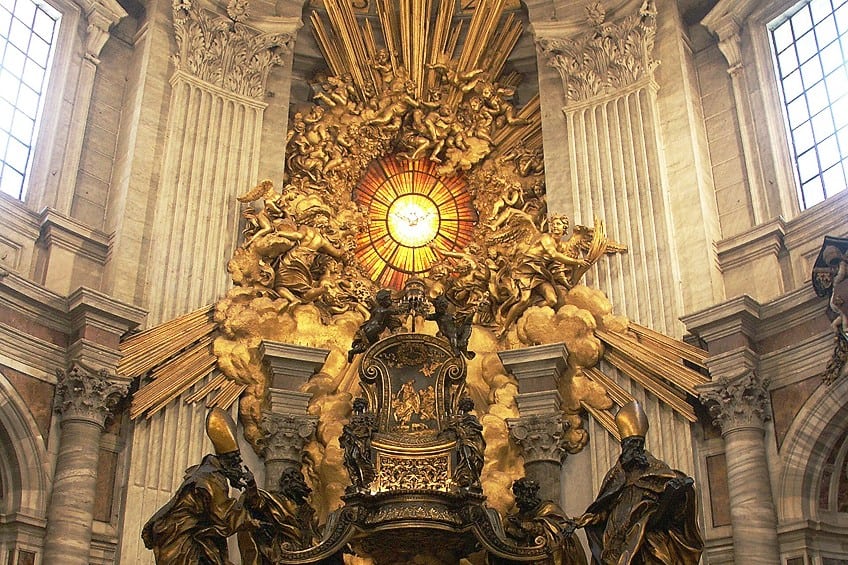“Chair of St. Peter” by Gian Lorenzo Bernini – Sculpting Faith
Where is the Chair of St. Peter located, and why is it called the Pope’s throne? This Vatican throne is located in St. Peter’s Basilica in the Vatican City and was said to be the throne of the first pope, Saint Peter the Apostle. Today, we shall explore the Chair of St. Peter by Gian Lorenzo Bernini, as well as learn about the Feast of the Chair of St. Peter.
Exploring the Chair of St. Peter by Gian Lorenzo Bernini
| Artist Name | Gian Lorenzo Bernini (1598 – 1680) |
| Date of Completion | 1666 |
| Medium | Gilt bronze |
| Dimensions | Unspecified |
| Current Location | St. Peter’s Basilica, Vatican City |
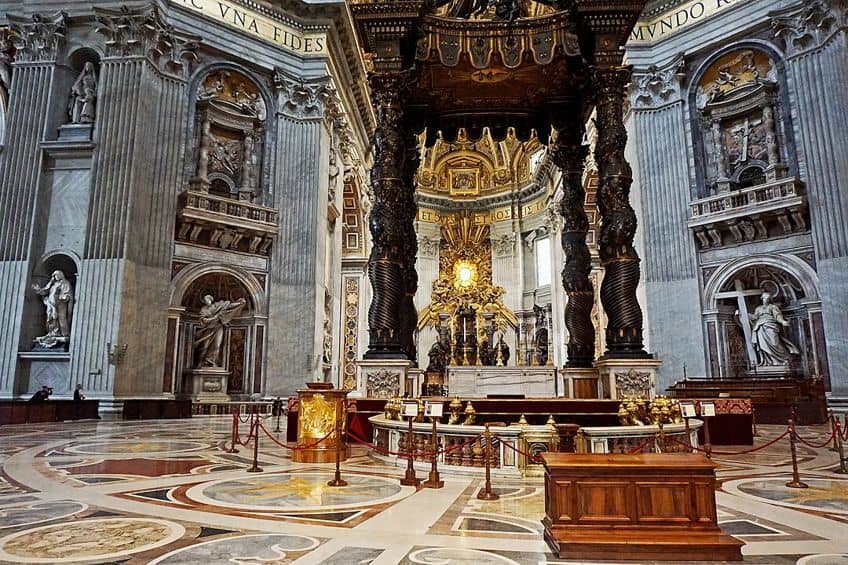
The Chair of St. Peter is a relic kept at St. Peter’s Basilica in Vatican City, the Pope’s independent zone inside Rome, Italy. This wooden Vatican throne is said to have belonged to Saint Peter the Apostle, the first Pope and the early Roman Christian leader. The relic is contained within a sculpted gilded metal enclosure designed and built by the artist, Gian Lorenzo Bernini, from 1647 to 1653.
Pope Benedict XVI defined the chair in 2012 as a symbol of the saint’s special mission to look after Christ’s flock, keeping it unified in charity and faith.
In 875 CE, Charles the Bald, Emperor of the Romans, presented the wooden throne to Pope John VIII. The relic has been examined several times throughout the years, most notably between 1968 to 1974, when it was taken from the Bernini altar for the last time. The analysis found that it was a single chair with a covering and that not a single component of the relic could be dated earlier than the 6th century. The pope’s throne is the church’s second altar, the first being the one located under the Baldacchino. It also acts as a reminder of the Catholic Church’s power to visitors.
Description of the Chair of St. Peter by Gian Lorenzo Bernini
The relic has been described as an old oaken chair with many worms and damage caused by cuts. Metal rings are affixed to either side of the chair, enabling it to be used as a sedia gestatoria. The back and front of the pope’s throne are finished with carved ivory. It was photographed and presented for veneration in 1867. The reliquary, like many others from the medieval period, takes on the form of the relic it guards, in this case, a chair. The chair created by Gian Lorenzo Bernini has no counterpart in furniture of its time.
It is made of scrolling members and encloses a coved panel with a low relief of Jesus commanding the saint to tend to his sheep as the upholstery pattern.
Large angelic figures surround an openwork panel under a bronze seat cushion within which the relic is encased. The cathedral is bolstered by four bronze Doctors of the Church: Western doctors Saint Augustine of Hippo and Saint Ambrose located on the outsides, both wearing miters, and Eastern doctors Saint Athanasius and Saint John Chrysostom located on the insides, both bare-headed.
The cathedra seems to hang in the apse of the basilica over the altar, illuminated by a central tinted glass through which light floods, lighting the gilded brilliance of sculpted clouds and sunrays that surround the window. This is a quintessential fusion of the Baroque arts, uniting sculpture and lavishly polychrome building and controlling light effects, similar to Bernini’s Ecstasy of Saint Theresa.
Beyond this altar is Bernini’s monument containing the Vatican throne, which is said to represent the Bishop of Rome’s power as successor to Saint Peter.
The Pope’s throne, like a committee chair, alludes to the individual rather than the furniture. Its initial owner fumbled a little, rejecting Christ three times, and was hesitant to accept Gentiles into the fledgling Church. Some of its subsequent occupants have likewise fumbled, and in certain cases, failed scandalously. On their own, we may believe that a specific pope may have let us down in one way or another. Still, the office exists as a reminder of the long history we respect, as well as a focal point for the entire Church.
The Feast of the Chair of St. Peter
Historical martyrologies show that hundreds of years before Charles the Bald, two liturgical feasts were held in Rome in memory of previous chairs linked with Saint Peter the Apostle, one of which was retained in the baptismal chapel of Old St. Peter’s Basilica and the other in the catacomb of Priscilla. These events took place on the 18th of January as well as the 22nd of February. There is no extant chair associated with either of these chairs.
The feasts were connected with an abstract notion of the “Chair of Saint Peter”, which via synecdoche denotes the Pope’s episcopal position as Rome’s bishop, an office said to have been initially held by Saint Peter and therefore extended to the diocese.
While both of these feasts were initially identified with Saint Peter’s visit to Rome, according to historians, the ninth-century version of the Martyrologium Hieronymianum connected the 18th of January feast with the time he spent in Rome and the 22nd of February feast with his time in Antioch. The feasts were added to the Double in the Tridentine Calendar, which Pope Clement VIII advanced to the newly formed rank of Greater Double in 1604.
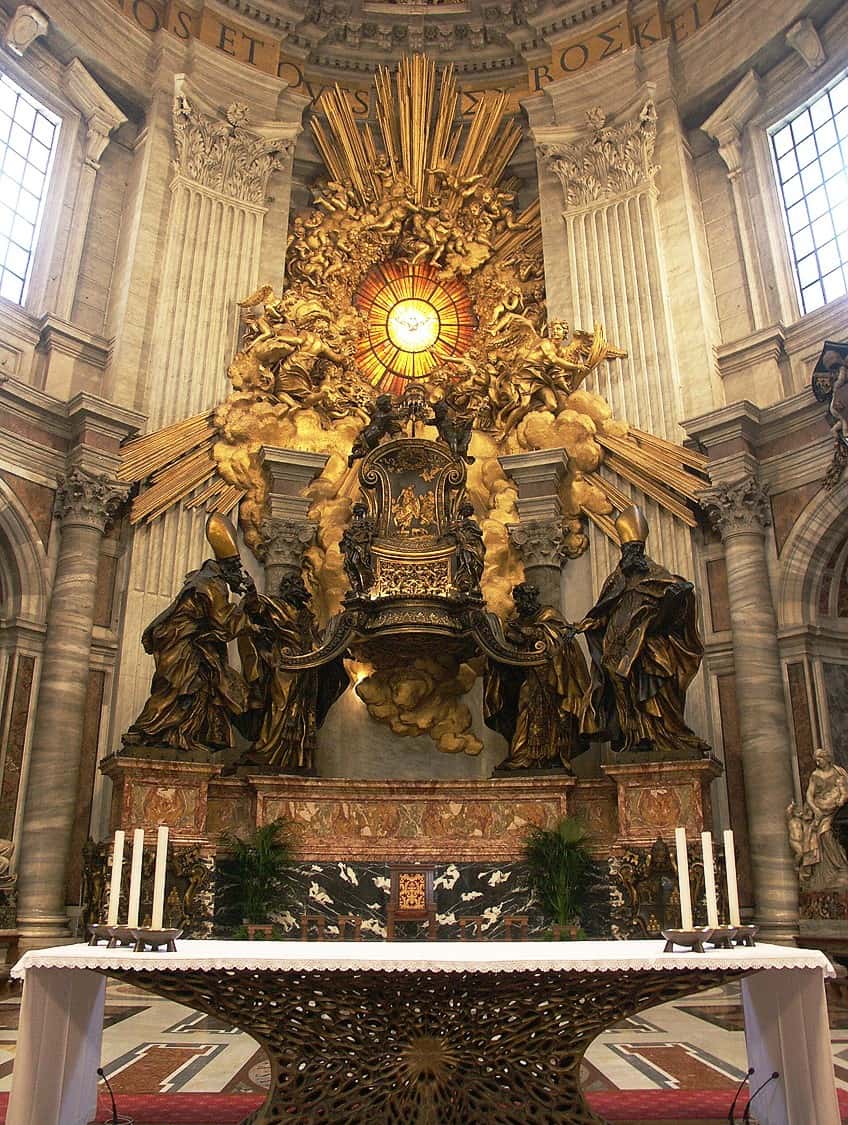
The 18th of January feast was removed from the General Roman Calendar by Pope John XXIII in 1960, in addition to several other feast days that were identical feasts of a single mystery or saint. The 22nd of February was declared a Second-Class Feast.
Who Is Saint Peter the Apostle?
According to the Bible’s New Testament, Saint Peter was initially a Galilean fisherman who was summoned by Christ to serve as one of his followers. He was regarded as a significant figure among the apostles and was often considered to be their leader. Saint Peter is recognized for his steadfast faith and impetuous personality, which led to both incredible confessions of faith and remarkable mistakes. According to Christian doctrine, Christ handed Saint Peter the keys to heaven, symbolizing his authority.
Following the death of Jesus and his subsequent resurrection, Saint Peter rose to prominence in early Christian society.
He is well-known for his miracles and for spreading the Gospel. According to legend, Saint Peter was killed in Rome during Emperor Nero’s reign, when he was crucified upside down at his own request, believing he was undeserving to die in exactly the same way as Christ. Saint Peter’s importance in Christianity can be observed in a number of ways. He is regarded as the foundation upon which Christ founded his Church, and his words and acts are documented in the New Testament.

Who Was Gian Lorenzo Bernini?
Bernini was an Italian painter and architect who flourished in the 17th century. He is widely recognized as one of the most influential people in Western art history, notably for the contributions he made to the Baroque style. He started out as a sculptor, producing complex and dynamic sculptures that showcased his talent for expressing feelings and motion in stone.
Bernini’s sculptures are notable for their realistic features and dramatic emotions, and they typically portray religious and mythical topics.
His sculptures typically have a dramatic feel to them, with exquisite detailing and skilled use of shadows and light. Bernini was an exceptional architect along with his sculptural accomplishments. He created a number of churches, structures, and chapels. Bernini mostly worked in Rome, where he was endorsed by various popes and important individuals of the time. His artistic ability and adaptability extended beyond sculpting and architecture to painting, sketching, and even stage design for theater plays.
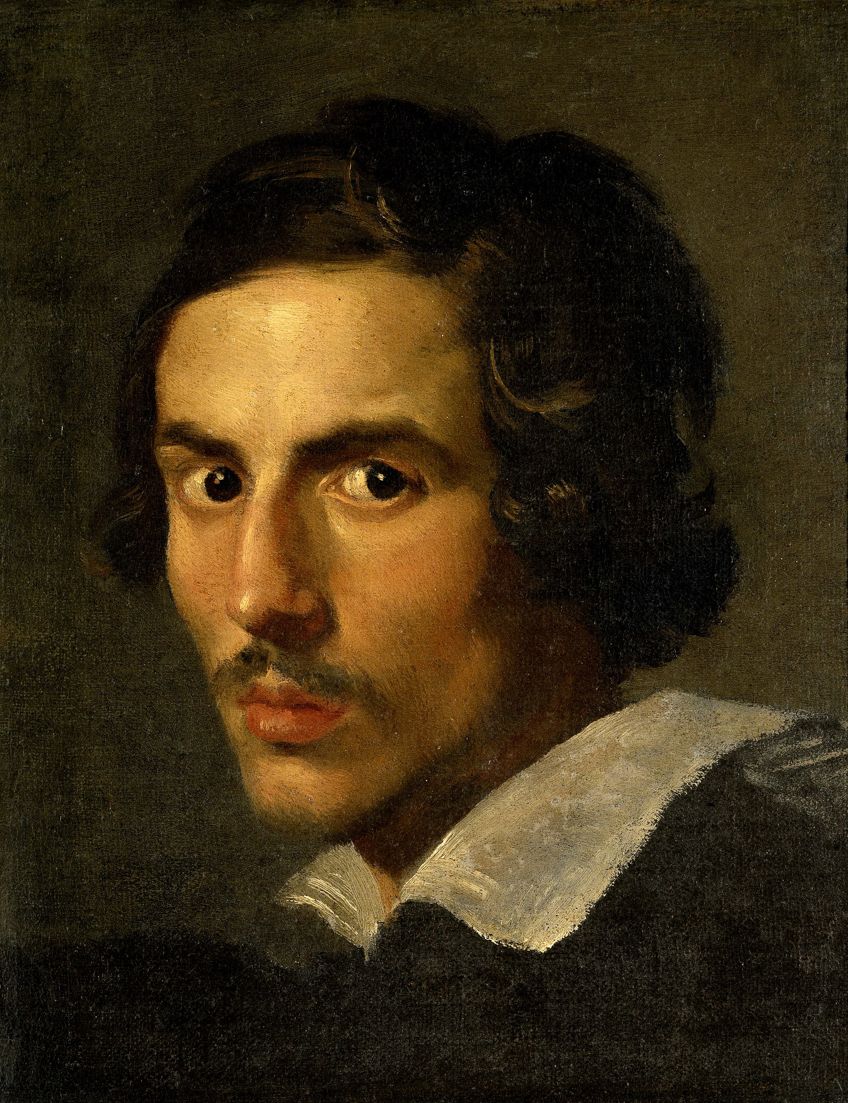
Visiting the Pope’s Throne
For many Catholic tourists and pilgrims who visit St. Peter’s Basilica in Vatican City, seeing the Chair of St. Peter is a life-changing event. It is conveniently accessible to tourists and draws millions of people every year. The basilica is located in the Vatican City’s center and is conveniently accessible via public transit. The entrance fee to St. Peter’s Basilica is free, however, there may be long lines, particularly during busy tourist seasons. It is better to try and arrive early in the day or think about booking a tour with a guide that includes skip-the-line access.
The Chair of St. Peter by Gian Lorenzo Bernini is positioned behind the main altar in the basilica’s apse.
The chair itself is not open to the public since it is a respected symbol as opposed to an actual seat. Tourists can, however, view it from afar to comprehend its significance. Take time for spiritual meditation while visiting the Vatican throne. Contemplate the papacy’s historical and theological significance, as well as St. Peter’s position as the first Pope. Contemplating the development of Christianity and the unification of the Church under the supervision of the Pope can be a profound experience for many people.
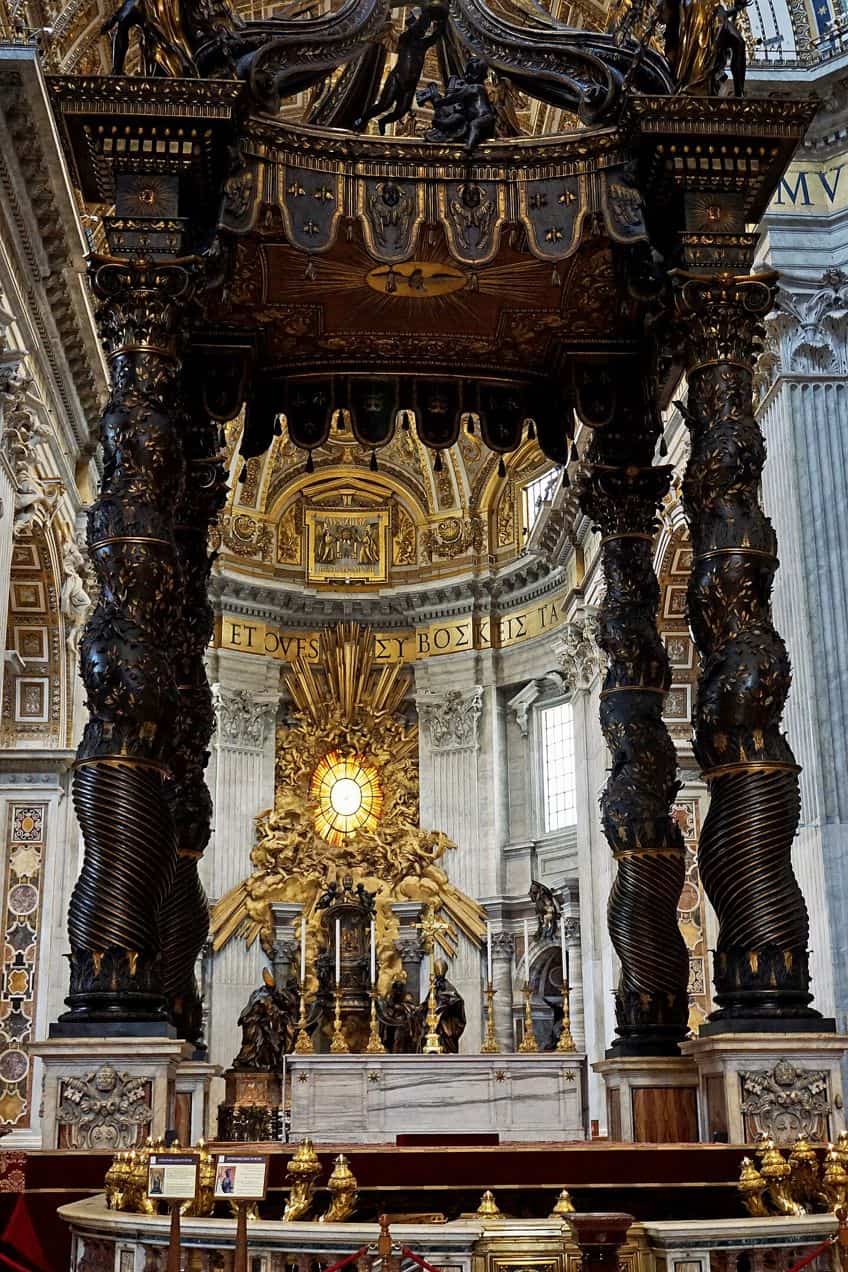
Please be aware that St. Peter’s Basilica is considered a holy place of worship, so please be polite throughout your visit. Tourists are asked to observe silence, acceptable behavior, and reverence. Photography is permitted, however, please be aware of any limits or rules in place. The spiritual significance of St. Peter’s Chair stems from its relationship to the uninterrupted line of popes throughout Christian history who have carried on the mission entrusted to Saint Peter by Christ. It acts as a continuous reminder of the Church’s unity under the guidance of the Pope, as well as the significance of apostolic succession.
That concludes our look at the Chair of St. Peter by Gian Lorenzo Bernini. The Chair of St. Peter represents St. Peter’s authority as the Catholic Church’s first pope. The Chair of St. Peter is an antiquated wooden chair set in St. Peter’s Basilica’s apse. The chair itself is not available to the public since it is a sacred relic and is not meant to be seated on. Instead, it is encased in a spectacular bronze edifice built by Gian Lorenzo Bernini and set conspicuously behind the basilica’s main altar. It serves as a symbol of the Pope’s power and his function as the global Church’s shepherd.
Frequently Asked Questions
Where Is the Chair of St. Peter Located?
The Chair of St. Peter by Gian Lorenzo Bernini is located in the Vatican City’s St. Peter’s Basilica. The basilica is built on the traditional spot where St. Peter, one of Christ’s 12 apostles, was thought to be buried. The ancient basilica was built in the fourth century, while the current construction comes from the 16th. It was designed by several prominent architects, including Michelangelo, Bernini, and Bramante. St. Peter’s Basilica’s interior is similarly stunning. Beautiful mosaics, sculptures, and artwork fill the enormous nave. The main altar is just over St. Peter’s burial place of rest. The Basilica of St. Peter serves as a destination of pilgrimage, worship, and creative inspiration.
What Is the Feast of the Chair of St. Peter?
The Feast of the Chair of St. Peter commemorates the Apostle’s services to the Christian Church. It commemorates his authority and never-ending efforts to construct a strong community based on Christ’s teachings, and it has been commemorated since the beginning of the Christian period. St. Peter was thought to have the keys to the kingdom of heaven, which Jesus had handed to him. St. Peter became a revered figure in the Christian faith for this and other reasons. At first, the Feast was observed on the 18th of January, as well as on the 22nd of February. The Saint delivered his first sermon in Rome on the 18th of January, and his first sermon in Antioch on the 22nd of February. One of the primary reasons for honoring the Feast of the Chair is to commemorate the Christian Church’s unity. Another significant reason is that the Chair represents Saint Peter’s authority and determination to lay a solid foundation for the Church. Saint Peter is respected across the Christian world and is a significant figure in the Vatican’s history. He is regarded as the first Pope and this feast commemorates the Papacy’s lengthy reign in Rome since the first century.
Jordan Anthony is a Cape Town-based film photographer, curator, and arts writer. She holds a Bachelor of Art in Fine Arts from the University of the Witwatersrand, Johannesburg, where she explored themes like healing, identity, dreams, and intuitive creation in her Contemporary art practice. Jordan has collaborated with various local art institutions, including the KZNSA Gallery in Durban, the Turbine Art Fair, and the Wits Art Museum. Her photography focuses on abstract color manipulations, portraiture, candid shots, and urban landscapes. She’s intrigued by philosophy, memory, and esotericism, drawing inspiration from Surrealism, Fluxus, and ancient civilizations, as well as childhood influences and found objects. Jordan is working for artfilemagazine since 2022 and writes blog posts about art history and photography.
Learn more about Jordan Anthony and about us.
Cite this Article
Jordan, Anthony, ““Chair of St. Peter” by Gian Lorenzo Bernini – Sculpting Faith.” artfilemagazine – Your Online Art Source. August 28, 2023. URL: https://artfilemagazine.com/chair-of-st-peter-by-gian-lorenzo-bernini/
Anthony, J. (2023, 28 August). “Chair of St. Peter” by Gian Lorenzo Bernini – Sculpting Faith. artfilemagazine – Your Online Art Source. https://artfilemagazine.com/chair-of-st-peter-by-gian-lorenzo-bernini/
Anthony, Jordan. ““Chair of St. Peter” by Gian Lorenzo Bernini – Sculpting Faith.” artfilemagazine – Your Online Art Source, August 28, 2023. https://artfilemagazine.com/chair-of-st-peter-by-gian-lorenzo-bernini/.


